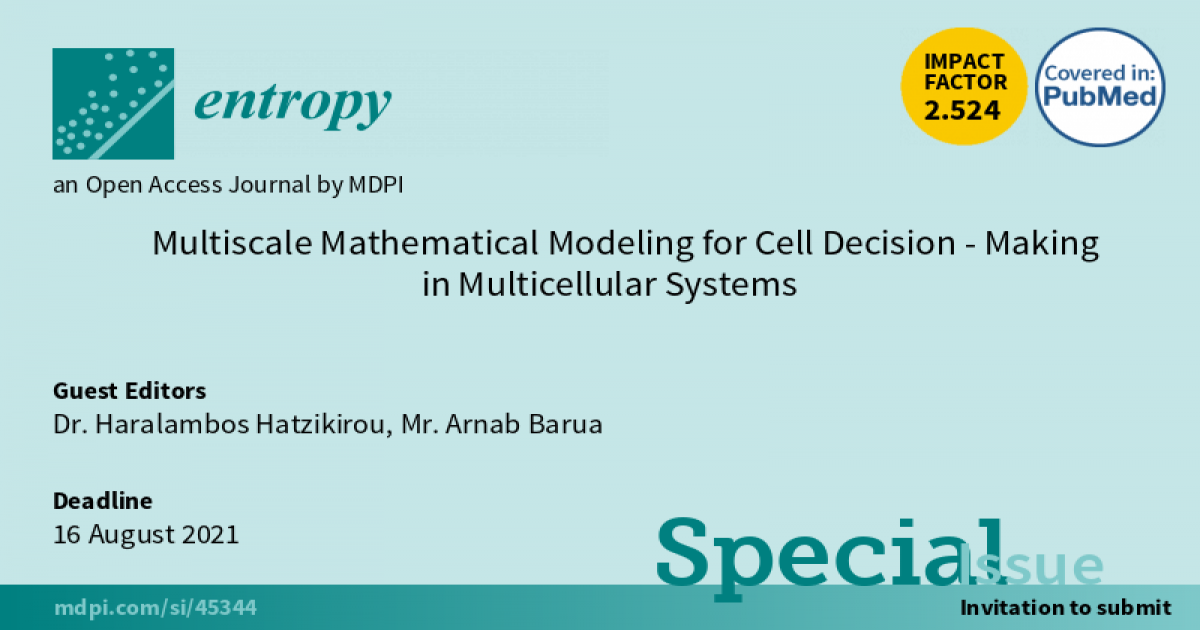Multiscale Mathematical Modeling for Cell Decision-Making in Multicellular Systems
A special issue of Entropy (ISSN 1099-4300). This special issue belongs to the section "Entropy and Biology".
Deadline for manuscript submissions: closed (16 August 2021) | Viewed by 24800

Special Issue Editors
2. Mathematics Department, Khalifa University, Abu Dhabi P.O. Box 127788, United Arab Emirates
Interests: mathematical biology; systems medicine/biology; cell decision-making; multi-scale modeling; non-equilibrium dynamics
Special Issues, Collections and Topics in MDPI journals
Special Issue Information
Dear Colleagues,
Cell decision-making is the process of cells responding to their microenvironmental cues. Cell decision-making phenomena have been well-studied in the context of single cells. However, how cells make decisions in their multi-cellular environment still remains elusive. Statistical physics and information theory offer a unique toolbox to study cell decisions in their multicellular environments since it allows for (1) low-dimensional description of relevant dynamics and (2) coupling between single cell decisions and the corresponding collective behavior at the multicellular level. Eukaryotic or prokaryotic (bacterial) phenotypic plasticity and cell fate determination are prime paradigms of such cell decision-making impacting all aspects of multicellular behavior, such collective migration, tissue development, and tumor growth. In this Special Issue, we intend to shed light on the latest developments on these aspects.
Prof. Haralampos Hatzikirou
Mr. Arnab Barua
Guest Editor
Manuscript Submission Information
Manuscripts should be submitted online at www.mdpi.com by registering and logging in to this website. Once you are registered, click here to go to the submission form. Manuscripts can be submitted until the deadline. All submissions that pass pre-check are peer-reviewed. Accepted papers will be published continuously in the journal (as soon as accepted) and will be listed together on the special issue website. Research articles, review articles as well as short communications are invited. For planned papers, a title and short abstract (about 250 words) can be sent to the Editorial Office for assessment.
Submitted manuscripts should not have been published previously, nor be under consideration for publication elsewhere (except conference proceedings papers). All manuscripts are thoroughly refereed through a single-blind peer-review process. A guide for authors and other relevant information for submission of manuscripts is available on the Instructions for Authors page. Entropy is an international peer-reviewed open access monthly journal published by MDPI.
Please visit the Instructions for Authors page before submitting a manuscript. The Article Processing Charge (APC) for publication in this open access journal is 2600 CHF (Swiss Francs). Submitted papers should be well formatted and use good English. Authors may use MDPI's English editing service prior to publication or during author revisions.
Keywords
- cell decision-making
- multicellular systems
- statistical physics
- information theory
- collective behavior
- non-equilibrium dynamics
Benefits of Publishing in a Special Issue
- Ease of navigation: Grouping papers by topic helps scholars navigate broad scope journals more efficiently.
- Greater discoverability: Special Issues support the reach and impact of scientific research. Articles in Special Issues are more discoverable and cited more frequently.
- Expansion of research network: Special Issues facilitate connections among authors, fostering scientific collaborations.
- External promotion: Articles in Special Issues are often promoted through the journal's social media, increasing their visibility.
- Reprint: MDPI Books provides the opportunity to republish successful Special Issues in book format, both online and in print.
Further information on MDPI's Special Issue policies can be found here.







